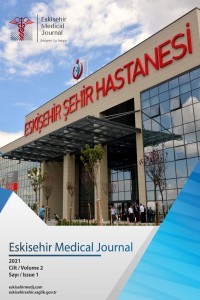TİP II DİYABET TANILI PERİFERİK ARTER HASTALARINDA ENDOVASKÜLER REVASKÜLARİZASYON SONUÇLARI
Balon anjiyoplasti, Diabetes mellitus, Periferik Arter Hastalığı
ENDOVASCULAR REVASCULARIZATION OUTCOMES IN PERIPHERAL ARTERIAL DISEASE PATIENTS WITH TYPE-II DIABETES MELLITUS
___
- 1. Aday AW, Matsushita K. Epidemiology of peripheral artery disease and polyvascular disease. Circulation research. 2021; 128:1818-32.
- 2. Pan Y, Luo Y, Hong J, et al. Advances for the treatment of lower extremity arterial disease associated with diabetes mellitus. Front Mol Biosci. 2022; 9: 929718.
- 3. Mohammedi K, Woodward M, Hirakawa Y, et al. Presentations of major peripheral arterial disease and risk of major outcomes in patients with type 2 diabetes: results from the ADVANCE-ON study. Cardiovasc Diabetol. 2016; 15: 129.
- 4. Nativel M, Potier L, Alexandre L, et al. Lower extremity arterial disease in patients with diabetes: a contemporary narrative review. Cardiovasc Diabetol. 2018; 17: 138.
- 5. Guariguata L, Whiting DR, Hambleton I, et al. Global estimates of diabetes prevalence for 2013 and projections for 2035. Diabetes Res Clin Pract. 2014; 103:137-49.
- 6. Buso G, Aboyans V, Mazzolai L. Lower extremity artery disease in patients with type 2 diabetes. Eur J Prev Cardiol. 2019; 26: 114-24.
- 7. Chow CY, Mathlouthi A, Zarrintan S, Swafford EP, Siracuse JJ, Malas MB. Outcomes of elective peripheral endovascular interventions for peripheral arterial disease performed in hospital outpatient departments, ambulatory surgical centers and office-based labs. J Vasc Surg. 2023; S0741-5214(23)00274-4.
- 8. Lee RE, Patel A, Soon SXY, et al. One year clinical outcomes of Rutherford 6 chronic limb threatening ischemia patients undergoing lower limb endovascular revascularisation from Singapore. CVIR Endovasc. 2022; 5: 32.
- 9. Song P, Rudan D, Zhu Y, et al. Global, regional, and national prevalence and risk factors for peripheral artery disease in 2015: an updated systematic review and analysis. Lancet Glob Health. 2019; 7: e1020-e1030.
- 10. Holman RR, Paul SK, Bethel MA, et al. 10-Year followup of intensive glucose control in type 2 diabetes. N Engl J Med 2008; 359: 1577–1589.
- 11. Marmagkiolis K, Kilic ID, Inanc IH, Iliescu C, Ajmal M, Cilingiroglu M. Superficial Femoral Artery Endovascular Therapy: 12-Month Primary Patency Rates of Contemporary Endovascular Devices from 25,051 Patients. J Invasive Cardiol. 2022; 34: E784-E792.
- 12. Giannopoulos S, Volteas P, Virvilis D. Specialty Balloons for Vessel Preparation During Infrainguinal Endovascular Revascularization Procedures: A Review of Literature. Vasc Endovascular Surg. 2023; 57: 599-606.
- 13. Yang J, Yue J, Chen X, et al. Safety and Efficacy of the Passeo-18 Lux Drug-Coated Balloon Catheter in Atherosclerotic Femoropopliteal Lesions: The Multicenter BIOLUX P-IV China Study [published online ahead of print, 2023 Feb 14]. Ann Vasc Surg. 2023; 93: 275-82.
- 14. Gebreyohannes EA, Netere AK, Belachew SA. Glycemic control among diabetic patients in Ethiopia: A systematic review and meta-analysis. PLoS One. 2019;14: e0221790.
- 15. Nagrebetsky A, Griffin S, Kinmonth AL, et al. Predictors of suboptimal glycaemic control in type 2 diabetes patients: the role of medication adherence and body mass index in the relationship between glycaemia and age. Diabetes Res Clin Pract. 2012; 96: 119-28.
- 16. Khattab M, Khader YS, Al-Khawaldeh A, Ajlouni K. Factors associated with poor glycemic control among patients with type 2 diabetes. J Diabetes Complications. 2010; 24: 84-9.
- 17. American Diabetes Association. Standards of Medical Care in Diabetes-2019 Abridged for Primary Care Providers. Clin Diabetes. 2019; 37: 11-34.
- 18. Kastrati A, Mehilli J, von Beckerath N, et al. Sirolimus-eluting stent or paclitaxel-eluting stent vs balloon angioplasty for prevention of recurrences in patients with coronary in-stent restenosis: a randomized controlled trial. Jama. 2005; 293: 165-71.
- 19. Kaya IÇ, Kaya FA. Radiation doses in endovascular revascularisation of lower-extremity arterial diseases. Cardiovasc J Afr. 2022; 33: 1-5.
- 20. Tan M, Takahara M, Soga Y, et al. Three-Year Clinical Outcomes Following Implantation of LifeStent Self-Expanding Nitinol Stents in Patients with Femoropopliteal Artery Lesions. Angiology. 2022; 73: 244-51.
- 21. Ouriel K, Adelman MA, Rosenfield K, et al. Safety of paclitaxel-coated balloon angioplasty for femoropopliteal peripheral artery disease. JACC: Cardiovascular Interventions, 2019: 12; 2515-24.
- 22. Scheinert D, Katsanos K, Zeller T, et al. A prospective randomized multicenter comparison of balloon angioplasty and infrapopliteal stenting with the sirolimus-eluting stent in patients with ischemic peripheral arterial disease: 1-year results from the ACHILLES trial. Journal of the American College of Cardiology. 2012: 60; 2290-95.
- 23. Tsujimura T, Takahara M, Iida O, et al. One-Year Clinical Outcomes following Implantation of InnovaTM Self-Expanding Nitinol Stents in Patients with Peripheral Artery Diseases Presenting Femoropopliteal Artery Lesions. J Atheroscler Thromb. 2019; 26: 847-55.
- 24. Chen S L, Whealon MD, Kabutey NK, Kuo IJ, Sgroi MD, Fujitani RM. Outcomes of open and endovascular lower extremity revascularization in active smokers with advanced peripheral arterial disease. Journal of Vascular Surgery 2017: 65, 1680-89.
- 25. Rosenfield K, Jaff MR, White CJ, et al. Trial of a paclitaxelcoated balloon for femoropopliteal artery disease. N Engl J Med 2015; 373: 145–53.
- ISSN: 2718-0948
- Yayın Aralığı: Yılda 3 Sayı
- Başlangıç: 2020
- Yayıncı: Eskişehir Şehir Hastanesi
PES PLANUS, TETİK NOKTA VE KAS GÜCÜ ARASINDAKİ İLİŞKİ
Fulya BAKILAN, Burcu ORTANCA, Ayşe AYDEMİR EKİM, Onur ARMAĞAN
PRIMER DİFFÜZ BÖBREK TUTULUMU ILE PREZENTE OLAN BİR MALT LENFOMA
Abdulkadir KARISMAZ, Elif SUYANİ, Mehmet Hilmi DOĞU, Gülben ERDEM HUQ, Istemi SERIN, Osman YOKUŞ
ATEROJENİK İNDEX İLE SABAH KAN BASINCI DALGALANMASI ARASINDAKİ İLİŞKİ
YENİDOĞANDA DEV BİR TEKA LUTEİN KİSTİ: NASIL YAKLAŞILMALI?
Aziz Serhat BAYKARA, Bahattin ERDOĞAN
Ahmet Lütfü SERTDEMİR, Mustafa DURAN, Ahmet Taha ŞAHİN, Abdullah İÇLİ, Mustafa ÇELİK, Sefa TATAR, Yakup ALSANCAK
PHOENİXİN’İN FİZYOPATOLOJİK ETKİLERİ
Muhammed TAŞAR, Raziye AKCILAR
TİP II DİYABET TANILI PERİFERİK ARTER HASTALARINDA ENDOVASKÜLER REVASKÜLARİZASYON SONUÇLARI
İbrahim Çağrı KAYA, Halil İbrahim BULUT
Cihan ÖZTÜRK, Metin BUDAK, Gökay TAYLAN, Kenan YALTA
ERİŞKİNLERDE D VİTAMİNİ DÜZEYİ İLE ASTIM KONTROLÜ ARASINDAKİ İLİŞKİ
Bilge SALIK, Merve AYIK TÜRK, Özgür BATUM, Berna KÖMÜRCÜOĞLU
